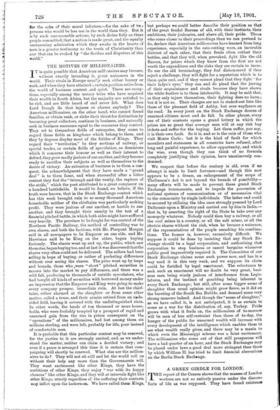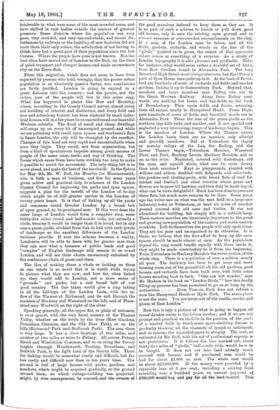A GREEN GIRDLE FOR LONDON.
MHE report of the Census shows that the masses of London workers are not so entirely passive under the discom- forts of life as was supposed. They have found existence intolerable in what were some of the most crowded areas, and have shifted in vast bodies outside the centres of greatest pressure. Some districts where the population was very poor, very crowded, and very uncomfortable, and recent dis- turbances by railways or the building of new factories did not leave them their only solace, the satisfaction of not having to think, have lost a great part of their population since the last Census. Where the people have gone is not known. But the best class have moved out of London to the East, on the lines of quick transport and cheaper houses, and made an enormous city on the Essex flats.
From this migration, which does not seem to have been expected by persons who hold, wrongly, that the poorer urban population is an absolutely passive factor, two conclusions are fairly justified. London is going to expand to a great distance into the country; and the poorer, not the richer, part of the people will live in this outer ring. What has happened in places like Bow and Bromley, where, according to the County Council survey, almost every old building of interest and distinction, and every field and tree and refreshing feature has been replaced by small indus- trial houses, will in afew years be re-enacted round our beautiful Western suburbs. The flood of small and cheap dwellings will surge up on every bit of unoccupied ground, and while we are pottering with small open spaces and workmen's flats in Inner London, the city will be strangled by the overflow. Changes of this kind are very rapid and uncontrollable when once they begin. They result, not from organisation, but from a kind of spontaneous impulse among great masses of people of the same class, needs, and way of thinking. The forces which cause them have been working too long to make it possible to arrest the movement. The only thing left is to move ahead, and make the best of the inevitable. In the Sphere for May 4th, Mr. W. Bull, the Member for Hammersmith, who is both a man of business, and has for some years given active and practical help to schemes of the London County Council for improving the parks and open spaces, suggests a plan for the benefit of the London of to-day which might be of still greater service to the London of twenty years hence. It is that of linking up all the parks and commons round Greater London by a broad belt of open ground, to be purchased now. If this were done the outer lungs of London would form a complete ring, some thirty-five miles round and half-a-mile wide, not actually a circle, because it would be longer than it is broad, but in any case a green girdle, studded from link to link with such jewels of landscape as the excellent differences of the London environs provide. If ever the scheme becomes a reality, Londoners will be able to learn with far greater ease than they can now what a treasure of public, lands and good "samples" of English landscape still remain to us round London, and will see their charm enormously enhanced by the continuous chain of grass and trees.
The idea of making these a whole or looking on them as one estate is so novel that it is worth while trying to picture what they are now, and how far, when linked up, they would add to London, not a mere series of " grounds " and parks, but a real broad belt of our good country. The line taken would give a ring taking in all the hill-tops of the London basin, with the in- flow of the Thames at Richmond, and its exit through the marshes of Hackney and Wanstead on the left, and of Plum- stead near Woolwich on the right of the river.
Speaking generally, all the upper flat, or plain of entrance, is river gravel, with the very finest scenery of the Thames Valley, whether on the levels by the river (Kew Gardens, Petersham Common, and the Old Deer Park), or on the hills (Richmond Park and Sudbrook Park). The area there is very large. It has a river frontage of two miles, and another of two miles or more to Putney. All across Putney Heath and Wimbledon Common, and so on along the Surrey heights through Wandsworth, Tooting, Streatham, and Dulwich Park, is the light land of the Surrey hills. There the linking would be somewhat costly and difficult, but far less costly and difficult now than in ten years' time. The ground is full of large houses with parks, gardens, and meadows, which might be acquired gradually, or the ground around them, on which cottage-building was projected, might, by wise management, be rescued, and the owners of
the good mansions induced to keep them as they are, It is no part of such a scheme to banish or pull down good old houses, only to save the existing open ground and to remove eyesores or overcrowded encroachments on the ring. If a map of the London area be taken, and all the fields, gardens, orchards, and woods on the line of the " girdle " painted in in green, the extent of that agreeable colour conies as something of a surprise. As a study of London topography it is also pleasant and profitable. Take, for instance, what would seem rather a doubtful set of links, from Kew Gardens round to Alexandra Park. The long Brentford High Street must always intervene, but Earl Percy's park of Syon House runs quite up to it. At the back of Brent. fordare hundreds of acres of orchards and fields and market gardens, linking it up to Gunnersbury Park. Beyond that, meadows and large mansions near Ealing run out to the Great Western Railway. Along from Ealing east- wards are nothing but farms and hay-fields to the back of Brondesbuiy. Then again fields and farms, retaining their old names, nearly to Hampstead Heath. From High- gate hundreds of acres of fields and beautiful woods run to Alexandra Park. There the line of the green girdle on the northern clay-hills ends, and another, and if not spoiled and neglected a very interesting, range of landscape begins. This is the marshes of London. Where the Thames enters the London basin there are no marshes, only alluvial and gravelly meadows. But at Tottenham the clayey or marshy valleys of the Lea, the Roding, and the Lower Thames begin,—Tottenham Marshes, Wanstead Flats and Park, Barking Levels, Hackney Marshes, and so on to the river. Neglected, covered with dust-heaps, old tin cans, and squalid sheds, what can be more dreary than such marshes P Kept as playgrounds, planted with willows and alders, studded with fishponds and osier-beds, iris-gardens and skating-pools, with broad flats of turf for cricket and football, and other reserves where grass and flowers are to grow till haytime, and then duly be made hay of, what can be more delightful P Much has been done to preserve these flats, but much more remains to be done. Some years ago the writer saw on what was the next field to a large new industrial town at Tottenham, at least six acres of meadow ground covered with old cans and kettles. It was not advertised for building, but simply left as a rubbish-heap. These eastern marshes are immensely important to the great and growing new population of the eastern and north-eastern outskirts. Left to themselves the people will only spoil them. They are too poor and unorganised to do otherwise. It is there, we believe, that the first effort to keep up the open spaces should be made almost at once. As the population beyond the ring would benefit equally with those inside it, they might be made contributory to it from the beginning. From Tottenham to Hackney Marsh is the worst section of the whole ring. There is a population of over a million, nearly all poor. The tendency has been to get more and more housing room out of the ground till all the old gardens, good houses, and orchards have been built over, with little mean houses standing back to back. "One can but wonder," says Mr. Hudson in his book on "London Birds," "how this deadly filling-up process has been permitted to go on so long by the
authorities Even Victoria Park does not refresh a man like Hampstead Heath or Hyde Park. The atmosphere is not the same. You are never out of the smells, smoke, and gloom of East London."
Now this is only a picture of what is going to happen all round London owing to the labour exodus ; and if we are not prompt and practical we shall be in the position of the parts of a morbid body in which some spore-shedding disease is gradually blocking all the channels of lymph or nutriment, and so causing the separated parts to atrophy. The cost, as estimated by Mr. Bull, with the aid of professional experts, is not prohibitive. If it follows the line marked out, about thirty-five miles of "girdle," half-a-mile wide, would have to be bought. It does not cut into land already much covered with houses, and if purchased soon could be had for about £1,000 an acre. The whole cost would be about L19,000,000. If the money were provided by a repayable loan at 5 per cent., including a sinking fund extending over a. hundred years, an annual payment of 2380,000 would buy and pay for all the land wanted. This sum of £380,000, and a large fund for repayment of capital, Would be provided by the improvement itself. The double frontage of seventeen miles; that is, thirt-four miles, might be let for a very large sum. Probably £3 a foot would not be an extravagant estimate. But if it were half that sum it would provide a rental of £270,000 per annum, or within 2110,000. of the annual cost.








































 Previous page
Previous page